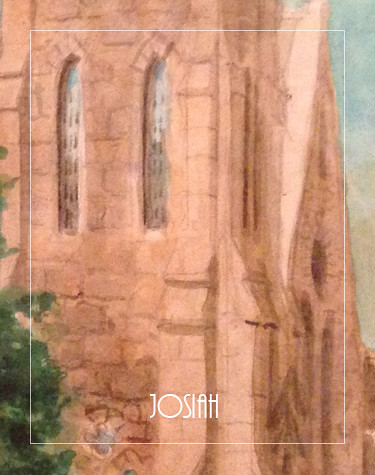
Volume XIV, Issue XIII
Josiah
By Bob Kirchman
Copyright © 2018, The Kirchman Studio, all rights reserved
Chapter 13: Intreat Me Not to Leave Thee
West concluded the meeting saying “You must think it over. We must know that this is something you do of your OWN volition. We have reached out to those who might be your fellow crewmen. Of course, they and you are sworn to secrecy. Just think, if the news media in the ‘Lower 48’ get a hold of this, they’ll start making all sorts of statements and demands. You know how they love to paint the Alaska Republic as a ‘cold and uncaring’ entity. Even though APOLLONIUS destroyed his own colony, they’ll make us the villains. They’ll accuse us of marooning the settlers there. There will be any number of ‘conspiracy theories.’”
I… must pray, and let you know then.”
In the days that followed, Josiah Zimmerman sought the continued counsel of Greene and Ben-Gurion, who for their part, happily gave him all the time he needed. Of course, he wanted the adventure, and the purpose of the mission. What would his parents think? What about his fiancé, Adila? He understood the secrecy and its necessity, but he didn’t even know who he was crewing with. In the Twenty-first Century such commitment to the unknown was rare to ask of anyone. It was something out of another time. So Josiah Zimmerman screwed up his nerve and sought out Dr. Greene, spilling his fears and concerns. The good doctor said little, but said he’d arrange a meeting soon to help him through this.
A week or so later, Greene sent a message that Josiah should come to the chapel office that afternoon at 2:00pm, Big Diomede Time. The young man arrived freshly showered and somewhat out of breath. He was surprised to see his parents and Adila there! With them were Sarah and Abiyah Ben-Gurion and their son Adam. “We are the first three people to set foot on Mars.” Abiyah said, and he went on to explain that Greene was not going to be there as he had a granddaughter’s dance recital to go to that afternoon. “Besides, he told me he’s pretty much out of advice for you anyway. He WILL be present to counsel you about another step you might take in life – one that I think will come up in the discussion this afternoon.”
Ben-Gurion continued “I’ve invited Adila’s parents to this meeting as well. I think you know Sarah and my story. The secret marriage and all – and you know how Adam was already with us when we set foot on Mars. Sarah touched the planet slightly before me, but that is for the historians to sort out. In the Guiness Book of World Records, we’re tied at the moment. Since Adila is fluent in five languages and aerospace studies as well, she was also a logical choice for this mission.”
Since our mission,” Sarah chimed in, “Mission Control has written stricter policies about things such as our ‘secret marriage,’ if you get my drift. But, since you have already made it quite clear that you are committed to each other, we just want to make sure you know that you need not decide without the benefit of blessing. And we sure do not want you deciding in the dark without input from those who love you.”
Adila spoke next: “Intreat me not to leave thee, or to return from following after thee: for whither thou goest, I will go; and where thou lodgest, I will lodge: thy people shall be my people, and thy God my God: Where thou diest, will I die, and there will I be buried: the LORD do so to me, and more also, if ought but death part thee and me.” – the words of Ruth to Naomi, but also much referenced in marital loyalty as well.
The two of them would follow in the footsteps of Abiyah and Sarah. They set to work planning their wedding.
(to be continued) [read more]
Pictures of Redemption
Stations of the Cross for Children
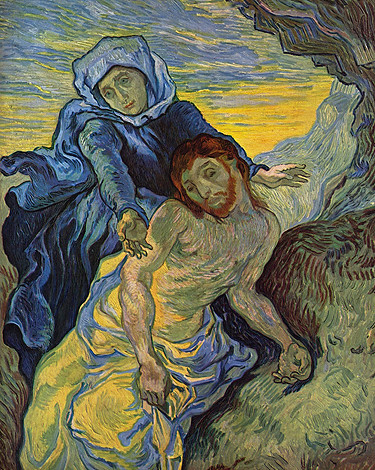
“Pieta” of Jesus and Mary Painted by Vincent Van Gogh in 1890.
Christ alone, of all the philosophers, magicians, etc., has affirmed eternal life as the most important certainty, the infinity of time, the futility of death, the necessity and purpose of serenity and devotion. He lived serenely, as an artist greater than all other artists, scorning marble and clay and paint, working in the living flesh. In other words, this peerless artist, scarcely conceivable with the blunt instrument of our modern, nervous and obtuse brains, made neither statues nor paintings nor books. He maintained in no uncertain terms that he made…living men, immortals.” – Vincent van Gogh in a Letter to Emil Bernard on June 26,1988.
I went with my oldest granddaughter to Stations of the Cross for Children at St. Francis’s Church in Staunton. I’d forgotten the richness of a simple retelling of Christ’s Passion with fourteen visual images. Young people took turns reading the narrative which shows the extent of Jesus’ suffering for our redemption proceeding from bas-relief image to image around the sanctuary. The Gospel account becomes visual and one can imagine the pain and sacrifice beginning with Jesus’ condemnation and ending with his burial. It is a fitting prelude to the great mystery of Resurrection celebrated at Easter.
First Station: Jesus in the Garden of Gethsemane
Then Jesus came with them to a place called Gethsemane, and he said to his disciples, "Sit here while I go over there and pray." He took along Peter and the two sons of Zebedee, and began to feel sorrow and distress. Then he said to them, "My soul is sorrowful even to death. Remain here and keep watch with me." He advanced a little and fell prostrate in prayer, saying, "My Father, if it is possible, let this cup pass from me; yet, not as I will, but as you will." When he returned to his disciples he found them asleep. He said to Peter, "So you could not keep watch with me for one hour? Watch and pray that you may not undergo the test. The spirit is willing, but the flesh is weak." (Matthew 26:36-41)
Second Station: Jesus, Betrayed by Judas, is Arrested
Then, while [Jesus] was still speaking, Judas, one of the Twelve, arrived, accompanied by a crowd with swords and clubs, who had come from the chief priests, the scribes, and the elders. His betrayer had arranged a signal with them, saying, "the man I shall kiss is the one; arrest him and lead him away securely." He came and immediately went over to him and said, "Rabbi." And he kissed him. At this they laid hands on him and arrested him. (Mark 14: 43-46)
Third Station: Jesus is Condemned by the Sanhedrin
When day came the council of elders of the people met, both chief priests and scribes, and they brought him before their Sanhedrin. They said, "If you are the Messiah, tell us," but he replied to them, "If I tell you, you will not believe, and if I question, you will not respond. But from this time on the Son of Man will be seated at the right hand of the power of God." They all asked, "Are you then the Son of God?" He replied to them, "You say that I am." Then they said, "What further need have we for testimony? We have heard it from his own mouth." (Luke 22: 66-71)
Fourth Station: Jesus is Denied by Peter
Now Peter was sitting outside in the courtyard. One of the maids came over to him and said, "You too were with Jesus the Galilean." But he denied it in front of everyone, saying, "I do not know what you are talking about!" As he went out to the gate, another girl saw him and said to those who were there, "This man was with Jesus the Nazorean." Again he denied it with an oath, "I do not know the man!" A little later the bystanders came over and said to Peter, "Surely you too are one of them; even your speech gives you away." At that he began to curse and to swear, "I do not know the man." And immediately a cock crowed. Then Peter remembered the word that Jesus had spoken: "Before the cock crows you will deny me three times." He went out and began to weep bitterly. (Matthew 26: 69-75)
Fifth Station: Jesus is Judged by Pilate
The chief priests with the elders and the scribes, that is, the whole Sanhedrin, held a council. They bound Jesus, led him away, and handed him over to Pilate. Pilate questioned him, "Are you the king of the Jews?" He said to him in reply, "You say so." The chief priests accused him of many things. Again Pilate questioned him, "Have you no answer? See how many things they accuse you of." Jesus gave him no further answer, so that Pilate was amazed.... Pilate, wishing to satisfy the crowd, released Barrabas... [and] handed [Jesus] over to be crucified. (Mark 15: 1-5, 15)
Sixth Station: Jesus is Scourged and Crowned with Thorns
Then Pilate took Jesus and had him scourged. And the soldiers wove a crown out of thorns and placed it on his head, and clothed him in a purple cloak, and they came to him and said,"Hail, King of the Jews!" And they struck him repeatedly. (John 19: 1-3)
Seventh Station: Jesus Bears the Cross
When the chief priests and the guards saw [Jesus] they cried out, "Crucify him, crucify him!" Pilate said to them, "Take him yourselves and crucify him. I find no guilt in him." ... They cried out, "Take him away, take him away! Crucify him!" Pilate said to them, "Shall I crucify your king?" The chief priests answered, "We have no king but Caesar." Then he handed him over to them to be crucified. So they took Jesus, and carrying the cross himself he went out to what is called the Place of the Skull, in Hebrew, Golgotha. (John 19: 6, 15-17)
Eighth Station: Jesus is Helped by Simon the Cyrenian to Carry the Cross
They pressed into service a passer-by, Simon, a Cyrenian, who was coming in from the country, the father of Alexander and Rufus, to carry his cross. (Mark 15: 21)
Ninth Station: Jesus Meets the Women of Jerusalem
A large crowd of people followed Jesus, including many women who mourned and lamented him. Jesus turned to them and said, "Daughters of Jerusalem, do not weep for me; weep instead for yourselves and for your children, for indeed, the days are coming when people will say, 'Blessed are the barren, the wombs that never bore and the breasts that never nursed.' At that time, people will say to the mountains, 'Fall upon us!' and to the hills, 'Cover us!' for if these things are done when the wood is green what will happen when it is dry?" (Luke 23: 27-31)
Tenth Station: Jesus is Crucified
When they came to the place called the Skull, they crucified him and the criminals there, one on his right, the other on his left. [Then Jesus said, "Father, forgive them, they know not what they do."] (Luke 23: 33-34)
Eleventh Station: Jesus Promises His Kingdom to the Good Thief
Now one of the criminals hanging there reviled Jesus, saying, "Are you not the Messiah? Save yourself and us." The other, however, rebuking him, said in reply, "Have you no fear of God, for you are subject to the same condemnation? And indeed, we have been condemned justly, for the sentence we received corresponds to our crimes, but this man has done nothing criminal." Then he said, "Jesus, remember me when you come into your kingdom." He replied to him, "Amen, I say to you, today you will be with me in Paradise." (Luke 23: 39-43)
Twelfth Station: Jesus Speaks to His Mother and the Disciple
Standing by the cross of Jesus were his mother and his mother's sister, Mary the wife of Clopas, and Mary of Magdala. When Jesus saw his mother and the disciple there whom he loved, he said to his mother, "Woman, behold, your son." Then he said to the disciple, "Behold, your mother." And from that hour the disciple took her into his home. John 19: 25-27
Thirteenth Station: Jesus Dies on the Cross
It was now about noon and darkness came over the whole land until three in the afternoon because of an eclipse of the sun. Then the veil of the temple was torn down the middle. Jesus cried out in a loud voice, "Father, into your hands I commend my spirit"; and when he had said this he breathed his last. (Luke 23: 44-46)
Fourteenth Station: Jesus is Placed in the Tomb
When it was evening, there came a rich man from Arimathea named Joseph, who was himself a disciple of Jesus. He went to Pilate and asked for the body of Jesus; then Pilate ordered it to be handed over. Taking the body, Joseph wrapped it [in] clean linen and laid it in his new tomb that he had hewn in the rock. Then he rolled a huge stone across the entrance to the tomb and departed. (Matthew 27: 57-60)
Closing Prayer:
Lord Jesus Christ, your passion and death is the sacrifice that unites earth and heaven and reconciles all people to you. May we who have faithfully reflected on these mysteries follow in your steps and so come to share your glory in heaven where you live and reign with the Father and the Holy Spirit one God, for ever and ever.
Amen.
A Capital Vision III
Harry Weese's Metro Design

Brookfield Properties.
The Bethesda Metro Station story is apparently far from over. Brookfield Properties, who own the plaza with the fountain, want to put a high-rise building on the site occupied by the fountain. Clark Properties, who own neighboring buildings, are concerned that the new building will cut off light and views to their adjoining buildings. Thus a new urban park has become part of the negotiations process. The proposal calls for a substantially greener plaza or park above the station as shown above. Here the escalator really rises into a park as Harry Weese originally envisioned it doing.
If Washington is beautiful as a Classical city, her suburbs are wild and untamed – a product of the Mid-Twentieth Century boom that created today’s megacity. Bethesda and Silver Spring are largely paved over at their centers and cry out for some public green space, even as her developers strive to get more out of her valuable commercial land.
A friend of mine introduced me to the work of San Francisco muralist Mona Caron, who’s work seems uniquely suited for installations in Washington’s sprawling urban overflow. Her work tells a story and like a good Frederic Church painting, contains many subtle details you have to look for.
It is not too unrealistic to envision a new Brookfield building with a mural taking enormous flowers up its side – rising from a true greenspace inserted into the heart of Urban Bethesda.
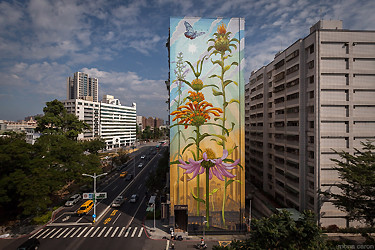
Mona Caron's Mural Outgrowing in Kaohsiung, Taiwan...
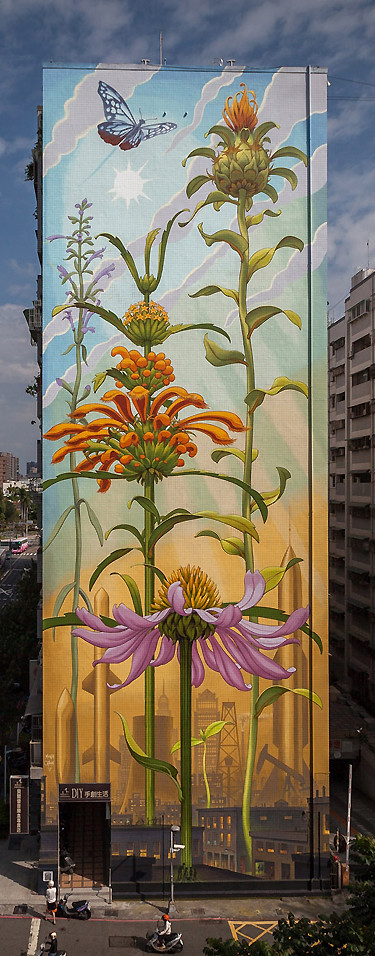
...rises for the entire height of an urban skyscraper.
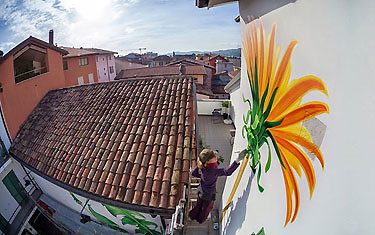
Mona Caron paints an enormous blossom.
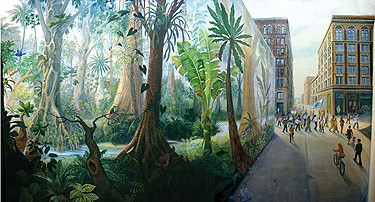
Mona Caron's work frequently juxtaposes natural scenes with urban fabric...
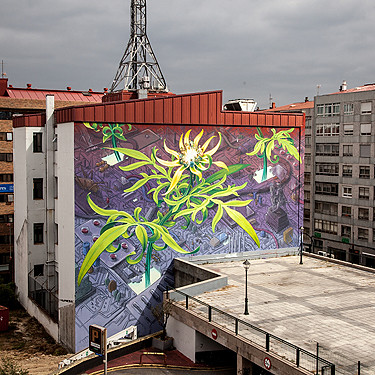
...and would provide a contrasting narrative in Washington's concrete suburbs.
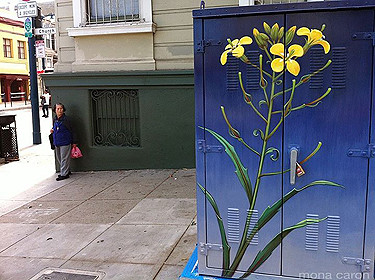
Mona Caron's unique approach...
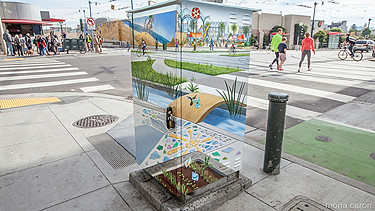
...to the ubiquitous utility box.
Vincent Van Gogh, The Story
Transformation
A powerful scene alludes to an even more powerful reality.
The Doctor: Between you and me, in a hundred words, where do you think Van Gogh rates in the history of art?
Curator: Well... um... big question, but, to me Van Gogh is the finest painter of them all. Certainly the most popular, great painter of all time. The most beloved, his command of colour most magnificent. He transformed the pain of his tormented life into ecstatic beauty. Pain is easy to portray, but to use your passion and pain to portray the ecstasy and joy and magnificence of our world, no one had ever done it before. Perhaps no one ever will again. To my mind, that strange, wild man who roamed the fields of Provence was not only the world's greatest artist, but also one of the greatest men who ever lived.
*****
And I heard a great voice out of heaven saying, Behold, the tabernacle of God is with men, and he will dwell with them, and they shall be his people, and God himself shall be with them, and be their God.
And God shall wipe away all tears from their eyes; and there shall be no more death, neither sorrow, nor crying, neither shall there be any more pain: for the former things are passed away.
And he that sat upon the throne said, Behold, I make all things new. And he said unto me, Write: for these words are true and faithful.”
-- Revelation 21:3-5
Worldview is everything. In Christ we have the one who actually transforms the pain and torment of this life into something beautiful. Here is a great truth that is beyond our understanding, yet the Divine Himself is the Master who completes the tapestries of our lives… inverting them to reveal His beautiful hand. This is a beautiful story, but may I suggest that it is beautiful because we yearn for what the Doctor and Amy were able to show Vincent and it is beautiful because Christ promises to show us the same. From C. S. Lewis and George MacDonald we learn that great story conveys great truth. Lewis shows us that those longings in us that this world cannot fulfill point to the fact that we were created for a better world.
History is not quite kind to Van Gogh, in fact the brief version often leaves you the memory of his madness. Yet here are some thoughts from the man himself. I think he is worthy of some study:
I feel that there is nothing more truly artistic than to love people.”
If you hear a voice within you say 'you cannot paint,' then by all means paint, and that voice will be silenced.”
Love many things, for therein lies the true strength, and whosoever loves much performs much, and can accomplish much, and what is done in love is done well.”
I wanted to know more, and in researching this I discovered William Havlicek, Ph. D , who wrote “Van Gogh’s Untold Journey” (Creative Storytellers). I knew that Van Gogh had some Faith because I had used a quote of his about church steeples a while ago. What I didn’t realize was the depth of his Faith.
Havlicek points out that the current drive by the academy toward secularization makes Van Gogh’s Faith practically unknown. Yet the man himself sought to serve God with his art: “…to try to understand the real significance of what the great artists, the serious masters, tell us in their masterpieces, that leads to God. One man wrote or told it in a book, another in a picture.”
And about his relationship with prostitute, Sien Hoornik, consider the man’s own writing: “I met a pregnant woman, deserted by the man whose child she carried. A pregnant woman who had to walk the streets in winter, had to earn her bread, you understand how, I took this woman for a model and have worked with her all winter. I could not pay her the full wages of a model, but that did not prevent my paying her rent, and, thank God, so far I have been able to protect her and her child from hunger and cold by sharing my own bread with her.”
Van Gogh struggled to support himself, but he was generous to a fault.
And about that suicide, Havlicek says that there is strong evidence that some boys were target shooting nearby and accidentally hit him. That he would not accuse them was entirely in line with his character. “He had a very sacrificial aspect to his personality. There were several times in his life when he took the blame for someone else.”
He loved Christ enormously at the end of his life,” Havlicek says. “He said Christ alone among all the magi and wise men offered men eternal life. In spite of a broken life, something glorious emerged.”
Vincent van Gogh’s Unappreciated
Journey with Christ
By Mark Ellis
[click to read]
A record 1.2 million visitors came to the giant retrospective of Van Gogh’s work in Amsterdam in 1990, which coincided with the 100th anniversary of the Dutch post-Impressionist’s death. What visitors did not see at that major exhibition were van Gogh’s Christian-themed paintings, which were left in the basement of the museum. (read more)
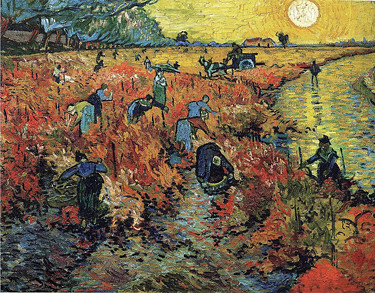
The Red Vineyards near Arles is an oil painting by the Dutch painter Vincent van Gogh, executed on a privately primed Toile de 30 piece of burlap in early November 1888. It is reported to be the only piece sold by the artist while he was alive. Savhanna Herndon
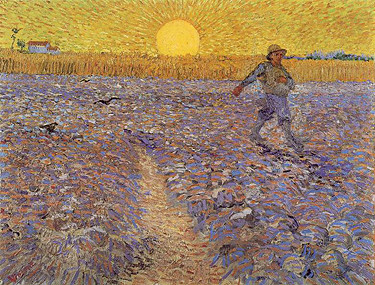
“I don’t hide from you that I don’t detest the countryside — having been brought up there, snatches of memories from past times, yearnings for that infinite of which the Sower, the sheaf, are the symbols, still enchant me as before.” (Letter 628 to his friend and painter Émile Bernard, on or about June 19, 1888).
Vincent Van Gogh, Le semeur (The Sower), Mid-June 1888. Oil on canvas, 64 x 80,5 cm. Kröller-Müller Museum,The Netherlands
Around the World in 80 Days
Blossoms in Snow
Photos by Bob Kirchman
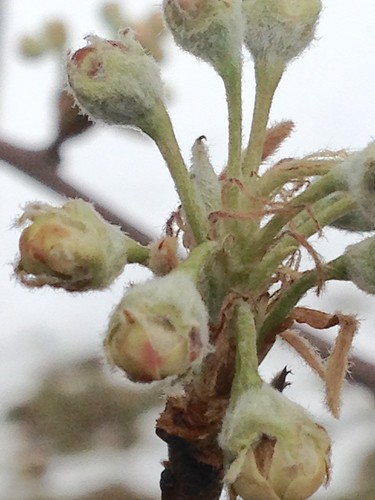
Bradford Pear.
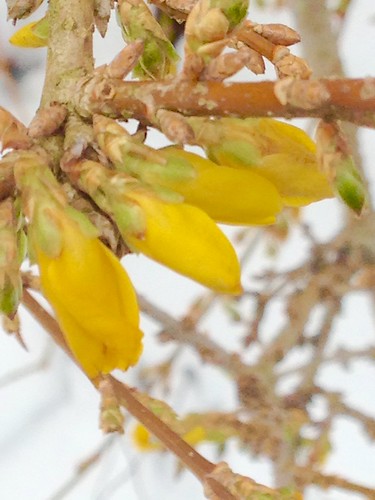
Forsythia.
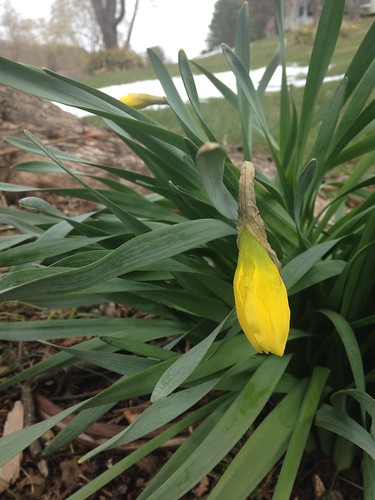
Daffodil.
